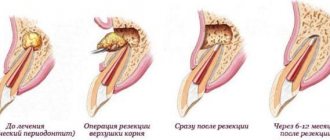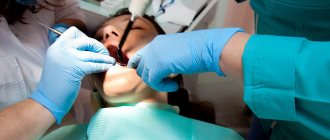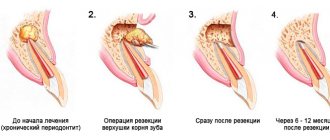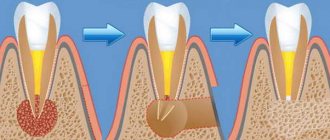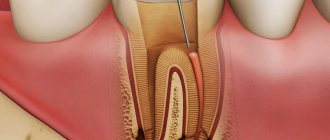Patients with chronic periodontitis often encounter a situation where a cyst forms at the apex of the root - a cavity in the bone tissue filled with pus. Most often, a cyst develops due to infection in the root canals; sometimes the cause of a cyst is trauma, inflammatory processes in the periodontium (gums) and adjacent areas. It can also occur due to undetected caries, pulpitis or periodontitis, as well as due to poorly filled root canals.
Such a neoplasm may not bother a person for a long time. As a rule, a cyst makes itself felt during periods of weakened immunity, against the background of a cold. In such cases, the infectious process in the cyst cavity worsens, which leads to abundant pus formation. The patient feels acute pain, swelling and swelling of the gums appears, and a fever may appear. The main thing is to seek dental care on time. In these cases, resection of the apex of the tooth root and dental surgery to remove the cyst are used. However, you can often get by with therapeutic treatment.
Treatment of dental cyst: methods
Most often, treatment of dental cysts is carried out jointly by dentists - a therapist and a surgeon.
Therapeutic treatment of a dental cyst is aimed at sanitation, or cleaning of the root canals - it is necessary to remove the source of infection and the cause of the cyst. First, the dentist-therapist processes the root canals and fills them with antiseptic paste for a period of 1 week to 1 month, as in the treatment of periodontitis. Then he fills the root canals with gutta-percha and sealer. Sometimes, especially in young patients, therapeutic treatment of the cyst is quite sufficient.
Surgical treatment is an operation to remove a cyst from bone tissue, sometimes this operation is accompanied by resection of the apex of the tooth root. The technique of apex resection is generally simple, but the operation is a complex surgical procedure and, like any operation, it must be taken seriously.
If resection is not done in time, the infection will spread upward through the root canals and can spread to the entire jaw. The consequence is that you may have to schedule the removal of all inflamed teeth. Therefore, you should not joke with such inflammations!
Do I need to do a resection or still remove the tooth?
Tooth root resection is a tooth-preserving operation. The dentist will recommend it to you when there is at least the slightest opportunity to save the tooth. If the dentist does not see this possibility, then the conversation will immediately focus on removal.
When will the tooth have to be removed?
- You have a large cyst that affects more than a third of the tooth or several teeth.
- The root of the tooth is destroyed.
- There is severe inflammation of the tissues adjacent to the diseased tooth.
- The tooth is movable.
- Subsequent prosthetic replacement of a diseased, destroyed tooth with a crown is impossible.
How is tooth root apex resection and cyst removal performed?
Typically, the entire procedure takes about an hour. In this case, the position of the tooth is important: surgery on distant teeth requires more skill and time.
During the operation, which is performed under local anesthesia, an incision is made in the gum near the diseased tooth to peel it away to expose the bone tissue. A small hole is then made in the bone using a special bur. Through it, the doctor should see the apex of the tooth root and the cyst attached to it.
Using a drill, the tip of the root is cut off and then removed from the wound along with the cyst attached to it. After the cyst is removed, synthetic bone is placed into the empty space to restore jaw bone tissue. At the end of the procedure, the mucous membrane of the gums at the incision site is sutured, sometimes a drainage is inserted between the sutures to drain the ichor from the operation site for several days.
When performing a tooth resection, only the inflamed and infected part of the root is removed, healthy tissue is not affected.
When should tooth resection not be performed?
- The main condition for successful root resection is the presence of sufficient jaw bone volume in the patient - at least 5 mm, otherwise there is a risk of jaw fracture.
- A tooth root resection operation will be ineffective if the patient has chronic periodontitis and/or periodontitis, as well as mobility of the diseased tooth.
Tooth root resection is contraindicated if:
- Large cysts or granulomas, when they reach the size of a third of the tooth root or more.
- A completely destroyed dental crown, if the tooth cannot be replaced with prosthetics.
- Close proximity of the roots of healthy teeth.
- Severe mobility of the diseased tooth.
- Some common diseases, such as diabetes, blood diseases, heart diseases, immunodeficiency conditions.
Cystectomy / root apex resection: indications, contraindications and causes
- The appearance of any neoplasm, for example, fibroma or other, larger than 1 cm.
- Incomplete or poor-quality root canal filling in the treatment of pulpitis, for example;
- Stump tab or pin in the dental canal;
- Damage to the root walls during tooth filling;
- Periodontitis, granulomas, cysts, fibromas;
- Perforation of the tooth root, fracture of the root or its apex;
- Curvature of the root canals or the apex of the tooth root;
- Presence of a foreign body;
- Inflammation near the site where the denture is installed;
- A fragment of a dental instrument in the canal;
Contraindications include periodontal disease, periodontitis, and the presence of a tumor at the location of the tooth.
What causes weight loss
Weight loss after sleeve gastroplasty occurs primarily due to a sharp decrease in the volume of the stomach and the creation of a mechanical obstacle to the passage of food. The gastric tube, the volume of which does not exceed 200 ml, quickly fills, the pressure in it increases and baroreceptors located at the entrance to the stomach transmit the corresponding signal to the brain. In this case, a person feels full after eating a small amount of food.
In recent years, it has become clear that longitudinal resection leads to a decrease in the blood concentration of the hunger hormone, ghrelin. This substance is produced by the mucous membrane of the fundus of the stomach - exactly the part that is removed during surgery. Excessive release of ghrelin by a distended stomach contributes to a strong feeling of hunger and increases the frequency of meals. Reducing the production of this hormone makes it easier for the patient to adhere to the diet and promotes faster weight loss.
Possible complications after cyst removal
Removing a cyst is a necessary procedure; the longer the treatment of a cyst is delayed, the more likely complications are to develop. There is no need to be afraid of removing a cyst; according to statistics, the percentage of possible adverse consequences is immeasurably less than complications from an unoperated cyst (abscess, phlegmon, sepsis).
After cystectomy, the service life of the tooth is not reduced. Both after therapeutic and surgical treatment of cysts, dynamic monitoring of the condition of the bone tissue is required.
To avoid complications, it is important to maintain oral hygiene, follow your dentist's recommendations, as well as eat a healthy diet and avoid alcohol, smoking, carbonated drinks and solid foods in the first days after surgery.
Types of bone grafting
The dentist-implantologist has several methods at his disposal to effectively restore bone volume, and their choice depends on the nature of the deficiency. In this case, we mean a vertical or horizontal tissue deficiency, that is, an expansion of the narrow alveolar process or an increase in its height to install an implant. The following innovations are recognized as the most popular among dental implantologists:
- implantation of bone tissue of biological or synthetic origin;
- expansion of the alveolar part of the bones of the upper jaw;
- targeted bone regeneration with the installation of a specific membrane;
- For bone tissue atrophy in the marginal areas of the upper jaw, a sinus lift is used.
Each of these methods has its own advantages, however, like any other intervention in the body, there are significant disadvantages of bone grafting of any kind. The most important disadvantage of this manipulation is considered to be a large time investment, that is, the process of restoring the required volume of bone tissue can reach 6-7 months. Another disadvantage of the maxillofacial reconstruction process is the cost of the procedure, and only wealthy people can afford professional dental implantation.
What do patients say about apex resection? Reviews are usually only positive!
“Resection of the top of the tooth took about an hour, the operation was performed under pain relief. It didn’t hurt very much near the tooth for about a month. A few months later I had to take an x-ray, the doctor showed that all the tissues had been restored."
“The cyst grew, they told me to remove it, it was a little unpleasant, but quite tolerable - the doctor quickly and accurately carried out the procedure. Everything was restored soon, now it’s completely unnoticeable that there was anything there.”
At Ritsa Dentistry, cyst removal operations are performed by experienced surgeons with extensive experience in performing such procedures. Therefore, you can rely on our professionalism and entrust the treatment of the cyst to our doctors.
How is the operation performed?
Sleeve surgery is performed under general anesthesia and takes 1.5-2 hours. For you, everything will look as if you simply fell asleep in the preoperative room, and woke up in your room. You simply won’t notice the procedure itself. The intervention is carried out as follows: a calibration probe 10-15 mm thick is inserted through the patient’s mouth into the stomach, around which a special suture is placed. This is how a gastric tube is formed, the diameter of which does not exceed one and a half to two centimeters. The remaining part of the stomach, up to 90% of its previous volume, is removed.
Surgeons of the Moscow Bariatric Group work through 5-6 punctures on the anterior abdominal wall. The length of each of them does not exceed 1 centimeter, which avoids the appearance of a large, unaesthetic scar on the abdomen. The punctures themselves are sutured with a cosmetic suture, so after healing they become almost invisible and do not raise questions among others. The doctor controls his actions using a laparoscope equipped with a high-quality optical device. Our clinic uses surgical optics “Karl storz”, which is rightfully considered one of the best in the world.
Preparing for surgery
We will prepare you for gastroplasty within 1 day. To do this, you will need to undergo gastroscopy, ECG, chest x-ray, ultrasound of the veins of the lower extremities. In addition, our laboratory will carry out all the necessary tests for you. This will ensure safety during surgery and minimize the risk of postoperative complications. Our bariatric center has everything you need for a full examination, so you do not have to visit other clinics and pay for additional procedures in third-party medical organizations.
Sign up for a consultation
Root removal steps:
- Carrying out activities for the administration of a local anesthetic drug;
- Separation of the circular ligament from the neck of the tooth, moving the gum tissue away from the edge of the alveolus;
- Cutting the gums and drilling out the bone tissue to provide access to the root (if necessary);
- The process of removing the root using forceps or a dental elevator. If a tooth has several roots, removal is carried out in parts;
- Treatment of the hole, suturing (if the gum is cut), treatment of the operated area.
It is important to understand that removing roots located on the upper jaw is different from removing roots located on the lower jaw. In the first case, special forceps are used, in the second - elevators. The technique for removing the roots of the upper jaw involves twisting single roots and dislocating parts of one root. As for the roots of the lower jaw, they are twisted.
Who is gastroplasty indicated for?
Longitudinal gastrectomy has the same indications as other bariatric surgeries. We consider the possibility of surgical intervention in the following cases:
- your body mass index is more than 40 kg/m2 (morbid obesity);
- BMI is above 35 kg/m2, if you have recently gained a lot of weight or have undergone a course of conservative therapy, which was ineffective;
- an intragastric balloon was previously installed, but this did not allow achieving the desired effect (“refractory” to balloon surgery);
- excess weight is accompanied by the presence of diabetes mellitus, arthrosis of the joints, severe hypertension and other pathologies associated with obesity.
For patients whose BMI exceeds 50 kg/m2, sleeve gastroplasty is performed only in combination with bypass surgery. Without this, the operation may be ineffective. Each case is considered separately by our surgeons. We take on work only if we are firmly convinced that the proposed procedure will help you get rid of excess weight and start a new life.
Who is contraindicated for gastroplasty?
Like any other abdominal surgery, sleeve gastroplasty has a number of contraindications. The intervention may be dangerous for you if you suffer from the following conditions:
- diseases of the digestive system in the acute stage (gastritis, esophagitis, pancreatitis, cholecystitis, ulcers);
- cardiac, respiratory, renal, liver failure;
- acute infections;
- conditions accompanied by a significant weakening of the immune system (cytostatic therapy for oncology, AIDS);
- bleeding disorders, increased bleeding or tendency to form blood clots;
- pregnancy and lactation;
- alcoholism, drug addiction;
- psychological unpreparedness for surgery.
Previously, it was believed that gastroplasty could not be performed on persons over 55 years of age and under 18 years of age. However, thanks to the technologies used in our clinic, as well as the many years of practical experience of Moscow Bariatric Group specialists, we are able to perform operations on patients starting from the age of sixteen. There is no upper age limit if your physical condition allows you to undergo the procedure under general anesthesia.
Features of postoperative rehabilitation
After such surgery, the patient should refrain from any physical activity for 24 hours. Eating food is allowed only after 3 hours. Subsequently, care must be taken to ensure that the oral cavity is not exposed to thermal irritants, to limit the consumption of spicy and salty foods, as well as the use of overly aggressive means for rinsing and brushing teeth.
Swelling may persist for 1-2 days and moderate pain may be felt. To prevent the development of a purulent and inflammatory process, antibacterial agents and antiseptic solutions are prescribed, which must be used to thoroughly rinse the mouth. After 6 months you should undergo an x-ray examination.
How will you lose weight after gastroplasty?
Longitudinal gastroplasty allows you to achieve weight loss of more than 60-75% of the original. That is, if initially your weight was 250 kg, then after the operation it can reach 70-80 kg. The first changes will become noticeable within 1 month after discharge from the hospital. For another 3-4 months, the weight will decrease very quickly, then the process will slow down a little. This is due to the fact that the body adapts to new living conditions and stabilizes metabolism.
On average, our patients lose about 1 kg per week for 2-3 years, after which their body weight becomes constant. In the long term, some weight gain is possible, which is caused by stretching of the gastric tube and an increase in the amount of food consumed. To prevent this from happening, you need to take care of yourself and strictly adhere to the diet, which Moscow Bariatric Group specialists will individually select for you. If necessary, you can contact our center again. We will help you make competent adjustments to your diet taking into account your changing needs.
What complications exist and how to deal with them
Like any other surgical operation, sleeve gastroplasty can lead to certain negative consequences. These include the following.
- general surgical complications (thrombosis of mesenteric veins, suture failure, bleeding, wound infection);
- hiatal hernia;
- functional obstruction of the operated stomach due to its bending;
- hypovitaminosis B;
- heartburn;
- weight gain in the long term.
The surgeons at our clinic are aware of all possible complications and take measures to prevent them. During the operation, the quality and tightness of all surgical sutures are carefully checked, the rules of asepsis and antisepsis are strictly observed, and innovative methods of work are used. After the intervention, the patient receives antibacterial drugs and agents to prevent the occurrence of blood clots. All this allows us to reduce the percentage of complications to a minimum. To date, negative consequences are recorded in no more than 1-2% of cases. All of them are successfully eliminated by the center’s specialists.
In order to completely eliminate postoperative problems or provide timely assistance if they arise, we will observe you in the hospital for 4-5 days after the operation. If problems arise after discharge, you can always contact us to solve them. The Moscow Bariatric Group staff includes doctors of many specialties, so you can undergo a comprehensive examination and receive advice from an endocrinologist, nutritionist, surgeon and other specialists. Together we will definitely select the optimal treatment plan for your treatment.
Price
240 000 ₽
Surgery: longitudinal resection (sleeve resection/drain)
What is included in this price:
All necessary tests
Preoperative preparation
Stay in a 3-bed room in a hospital (TV, shower, toilet, air conditioning). It is also possible to stay in single and double rooms for an additional fee.
Three meals a day
Operating team consisting of: Boris Yuryevich Tsvetkov, two assisting surgeons, operating nurse, anesthesiologist
The operation is performed laparoscopically. German expert-class equipment KARL STORZ is used
American-made staplers Johnson & Johnson
Inhalation anesthesia is non-toxic and safe. Imported drugs are used for anesthesia. The active effect of anesthesia stops 30 minutes after surgery. The patient comes to his senses. Residual effects are mild drowsiness. Can last up to 2 hours
Postoperative period: dressings, systems, consultations
Extract with written recommendations from the doctor
Consultation with a doctor within one year after surgery
Longitudinal gastrectomy
In the modern world, the number of overweight people far exceeds their number in previous generations.
There are many reasons for this - a sedentary lifestyle, consumption of fast food and other junk food, a large amount of stress and lack of attention to one’s own health.
As a result, the so-called “pleasant plumpness” for many turns into obesity, when exercise and proper nutrition can no longer save the situation.
In this case, the only effective solution to the problem is to reduce the size of the stomach - this allows you to significantly reduce the amount of food consumed and get rid of excess weight.
Longitudinal gastrectomy, also known as “DRAIN”, “PRG” and “longitudinal gastrectomy”, consists of reducing the volume of the organ by removing its larger (lateral) part. It is important to note that the physiological valves are preserved during this surgical intervention, so digestion after drainage proceeds completely normally.
After an operation for longitudinal resection of the stomach, instead of the traditional sac-like shape, the organ takes the form of a thin tube with a capacity of about one hundred milliliters. Now, food entering the stomach does not linger in it, but immediately enters the intestines, which leads to guaranteed weight loss. The effectiveness of the operation is also increased by the fact that the area of production of ghrelin, a hormone that causes appetite, is removed.
The advantage of PRG is the rapid restoration of the physiological functioning of the gastrointestinal tract and the absence of foreign objects in the abdominal cavity (unlike banding and ballooning).
Another advantage of longitudinal gastrectomy is the almost complete absence of restrictions on the age of patients - the operation is performed both on adolescents (for certain indications, even preschoolers) and on older people.
DRAIN is one of the most popular methods of treating obesity today.
The reduction in excess body weight as a result of the operation reaches 60%.
The world's first longitudinal gastrectomy operation was performed in the United States at the beginning of the 21st century. At that time, a biliopancreatic bypass was supposed to be performed after the prostate cancer, but it soon became clear that a second operation was not needed in most cases.
Patient's review after longitudinal gastrectomy
Possible complications after longitudinal gastrectomy
Like any surgical intervention, longitudinal gastrectomy carries a certain risk of various complications.
After removing part of the organ, the remaining part is sutured with staple sutures, and even with an ideal surgical intervention, there is still the possibility of bleeding.
According to statistics, the probability of such complications is 1.0%. However, such problems can be easily resolved in the hospital with repeated surgery (laparoscopic or surgical, depending on the situation), after which patients are discharged in satisfactory condition.
Since the operation for longitudinal resection of the stomach is carried out in sufficient proximity to the spleen, in the rarest cases of bleeding from it, it is possible to remove this organ. Heartburn is also possible during the first time after breast cancer. Patients must be warned about possible risks before undergoing surgery, and together with the doctor they choose the most suitable type of operation.
Despite the fact that PR is a relatively recent method of treating obesity, it is successfully used in many developed countries around the world.
The operation is performed under general anesthesia and lasts 1-3 hours. After the operation for longitudinal resection of the stomach, five scars remain on the patient’s abdomen - four small, 1 cm long, and one slightly larger - about 3 cm (through which the removed part of the stomach is removed). For women, another operation option is possible, when the remote area of the organ is evacuated transvaginally.
In this case, only four visible scars remain on the abdomen, their length is about 0.5 cm, and they are almost invisible. Many patients choose this option for performing prostate cancer, as it allows them to maintain the aesthetic appearance of the abdominal area and, moreover, does not in any way affect reproductive functions.
Patients often wonder whether gastric resection will lead to disability. The answer is clear - after PRJ, excess weight loss is guaranteed, so the quality of life increases significantly, walks, sports and various types of social activities become available.
Nutrition rules after longitudinal gastrectomy
A proper diet is the key to successful recovery after surgery. So, on the first day, patients should not drink liquid (its deficiency in the body is compensated by droppers). The next day, you can drink a tablespoon of water every 20 minutes. Next, it is important to observe the following principles:
- In the first postoperative week, only drinking is allowed;
- In the second week, you can add liquid food;
- During this period of time, it is necessary to exclude flour products;
- You need to eat small portions 6 times a day;
- In the third week after breast cancer, it is possible to add pureed food from the usual set of foods to the diet, but more than 150 ml of food should not be consumed at one time.
- The diet should be balanced, containing animal proteins, fiber, fermented milk products with live bacteria, vitamins, etc.
- In the first three months after breast cancer, it is recommended to primarily consume pureed foods.
Longitudinal gastrectomy is one of the most popular operations at the bariatric center of City Hospital No. 40 in St. Petersburg. Qualified doctors with the necessary knowledge and extensive experience in this area of medicine will select the optimal method of surgical weight loss for each patient. You can make an appointment by phone or through a special form posted on our website.
← Back

